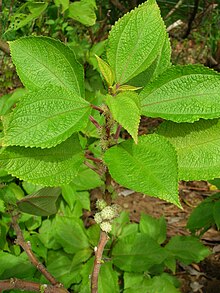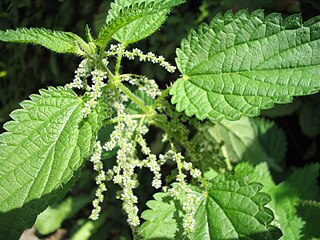
The Urticaceae are a family, the nettle family, of flowering plants. The family name comes from the genus Urtica. The Urticaceae include a number of well-known and useful plants, including nettles in the genus Urtica, ramie, māmaki, and ajlai.
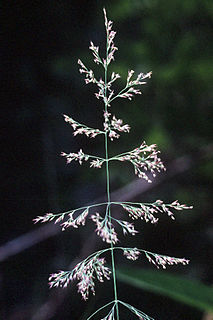
Calamagrostis is a genus in the grass family Poaceae, with about 260 species that occur mainly in temperate regions of the globe. Towards equatorial latitudes, species of Calamagrostis generally occur at higher elevations. These tufted perennials usually have hairless narrow leaves. The ligules are usually blunt. The inflorescence forms a panicle. Some may be reed-like.
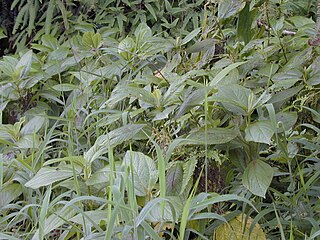
Boehmeria is a genus of 47 species of flowering plants in the nettle family Urticaceae. Of the species, 33 are indigenous to the Old World and 14 to the New World; no species is indigenous to both the Old and New Worlds. The species include herbaceous perennials, shrubs and small trees. Although related to the similar-looking species of the stinging nettles of genus Urtica, species of Boehmeria do not have stinging hairs. Because of the similarity in appearance, some species are commonly called "false nettles".

Aequatorium is a genus of flowering plants in the aster family. It was described as a genus in 1978. It is a member of the tribe Senecioneae and native to South America.

Mutisia is a genus of flowering plant in the mutisia tribe within the sunflower family. Mutisia has been named after José Celestino Mutis. It comprises about sixty species which can be found along the entire length of the Andes and in southern Brazil, Paraguay, Uruguay and northern Argentina.
Plagiocheilus is a genus of flowering plant in the Asteraceae family. It is now classified in tribe Astereae, but used to be placed with the Anthemideae.
- Plagiocheilus bogotensis(Kunth) Wedd. - Colombia, Ecuador, Peru
- Plagiocheilus ciliarisWedd. - Bolivia
- Plagiocheilus frigidusPoepp. & Endl. - Ecuador, Peru
- Plagiocheilus herzogiiBeauverd ex Herzog - Bolivia
- Plagiocheilus peduncularis(Kunth) Wedd. - Ecuador
- Plagiocheilus soliviformisDC. - Bolivia
- Plagiocheilus tanacetoidesHaenke ex DC. - Paraguay, Argentina

Bartsia is a genus of flowering plants in the broomrape family, Orobanchaceae.
Gyrotaenia is a genus of plants in the family Urticaceae.

Laportea is a genus of plants in the family Urticaceae.
Macrocnemum is a genus of plant in the family Rubiaceae. It contains the following species :
Pipturus schaeferi is a species of plant in the Urticaceae family. It is endemic to French Polynesia.
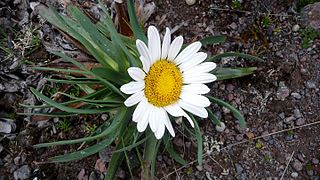
Werneria is a genus of South American plants in the groundsel tribe within the sunflower family.
Philodoria neraudicola is a moth of the family Gracillariidae. It was first described by Otto Swezey in 1920. It is endemic to the Hawaiian islands of Kauai, Oahu, Molokai and Hawaii.
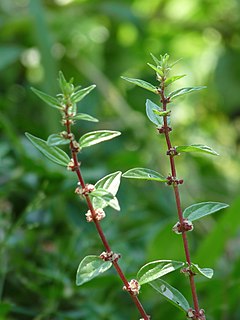
Pouzolzia is a genus of flowering plants in the nettle family. There are about 35 species distributed throughout the tropical world. Most are shrubs, and some are herbs. The genus was named for French botanist and plant collector Pierre Marie Casimir de Pouzolz (1785–1858).

Elatostema is a genus of flowering plants containing approximately 350 known species in the nettle family Urticaceae, native to tropical forest clearings throughout Australasia, Asia and Africa. There may be as many as 1,000 species of this little-known genus, which is susceptible to deforestation and other forms of human exploitation. Some species, for instance the recently discovered E. fengshanense, show unusual adaptations to growing in deep shade in caves. DNA analysis suggests that the three genera Elastostema, Pellionia, and Pilea be grouped together as one.

Loricaria is a genus of South American flowering plants in the pussy's-toes tribe within the sunflower family.
Maoutia is a genus of shrubs or small trees in the nettle family (Urticaceae). The leaves are alternate. The inflorescence branches dichotomously and the flowers are arranged in small clusters. The pistillate ("female") flowers have very small petals. Maoutia species resemble those of Leucosyke and Debregeasia.

Pipturus argenteus, known as false stinger, native mulberry, white mulberry, white nettle, amahatyan (Chamorro), and ghasooso (Carolinian), is a small tree native to Northern Australia, Guam, and the Commonwealth of the Northern Mariana Islands.
